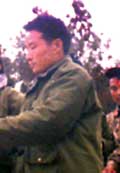 The Maoist strategy of replicating the party's military gains in the midwest in the eastern region appears to have suffered setbacks.
The Maoist strategy of replicating the party's military gains in the midwest in the eastern region appears to have suffered setbacks. Military sources say the rebels had used the ceasefire period earlier this year to transport a large number of their militia as well as weapons to the eastern region to launch major attacks on army and police bases. But the rebels appear to have realised now that the conditions in the east are different. There have also been reports of Maoists from the midwest having linguistic and cultural problems adjusting to the region.
Maoists captured by security forces have provided the army with information about rebel hideouts and training centers. The cadre do not seem to be as ideologically committed to the revolution as Maoists elsewhere, and military sources say rebels in the east have been quite willing to pass on vital information.
It was on the basis of a tip off from a captured Maoist that the security forces were able to raid a rented apartment of the rebels' eastern command military chief, Barshman Pun ('Ananta') in Dharan on 9 October. The raid yielded important documents, a computer with a work plan, a satellite phone with pre-paid SIM card from Singapore Telecom. Pun's aide was captured and provided information about the Maoist strategy in the east.
In mid-November the army raided the house of the Maoist eastern regional in-charge, Agni Sapkota in Janakpur. Earlier, the army was able to capture Gyanu Subba, the deputy chief of a Maoist-affiliated group who has been speaking out openly to the media against the Maoist leadership.
 Said one security source: "After the raids and the arrests, we have been successful in many of our offensives and have been able to arrest many more rebels." Most of them are said to be from the Maoist-associated Limbuwan Liberation Front and the Kirant Workers' Party, the source said. Brigadier General Man Dhoj Budhamagar at the army's eastern command headquarters told us the main reason for the Maoist setbacks have been differences between their political workers and the military wing. The Maoist party's relations with the associated Limbuwan and Kirat parties have also often been frayed.
Said one security source: "After the raids and the arrests, we have been successful in many of our offensives and have been able to arrest many more rebels." Most of them are said to be from the Maoist-associated Limbuwan Liberation Front and the Kirant Workers' Party, the source said. Brigadier General Man Dhoj Budhamagar at the army's eastern command headquarters told us the main reason for the Maoist setbacks have been differences between their political workers and the military wing. The Maoist party's relations with the associated Limbuwan and Kirat parties have also often been frayed. Another major setback for the Maoists was the battle in Khotang on 7 December in which an army patrol engaged the Maoists 17th Battalion C Company in a firefight and killed its commander, 'Utthan' and four female guerrillas. Earlier, the army had captured the 17th Battalion Commander, Manbahadur Malla (Sangharsha). Since the end of the ceasefire on 27 August there have been more than six major battles in Belbari, Karkigaun in Panchthar and in Chintapokhari and Bakachaul in Khotang.
The Maoists have admitted that they have suffered setbacks in the east. In a statement by the Mechi-Kosi Regional Bureau on 26 November, more than 70 guerrillas had been killed since the end of the ceasefire. The security forces say they have killed more than 450 Maoists in the eastern region in that period and captured large amounts of explosives and weapons. Eastern command chief, Major General Pradip Pratap Bam Malla also appears to be ahead of the rest of the country in setting up new volunteer civilian forces that arm and train villagers to fight the Maoists on their own.


